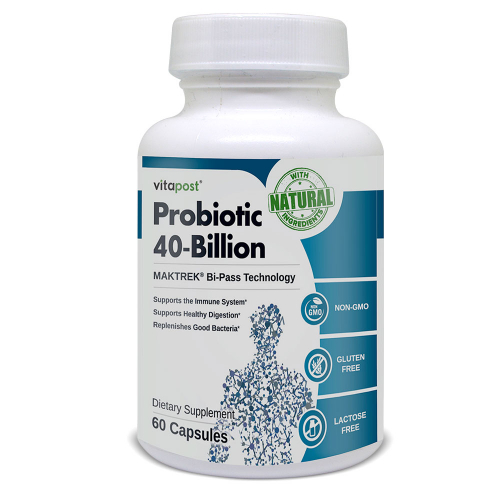Growing up, I was always scared of bacteria. It sounded like a dirty word, plus the idea of something living in my body was off-putting. I was so uneducated about bacteria to the point where I still avoid the yogurt aisle in the supermarket.
Perhaps this aversion to yogurt and other good bacteria foods contributed to an unhealthy gut flora.
So many of the causes for bad gut bacteria are common in our everyday life including sugar, GMO foods, and stress. It’s hardly surprising that in a year we can expect 22.4 million Americans to be diagnosed with digestive system disease.
The interesting thing about gut health is it reaches so much further than your digestive system. The gut microbiome may also support your immune system, brain health, mental health, weight, heart health, blood sugar… it feels as though the gut science community is finding just how powerful the gut microbiome is all the time.
How Can I Support My Probiotic Bacteria?

At the time of writing, the consensus stands that the most effective way to support healthy gut flora is to regularly eat foods abundant in friendly probiotic bacteria. These foods are usually fermented as fermented foods go through a process of lacto-fermentation, in which natural bacteria feed on the sugar and scratch in the food, creating lactic acid. As well as preserving the food, lacto-fermentation promotes beneficial enzymes, B vitamins, omega-3 fatty acids, and various species of good bacteria.
Some of the most popular forms of probiotic foods include yogurt, kefir, kombucha, sauerkraut, pickles, miso, tempeh, kimchi, sourdough bread and some cheeses.
Is Beer a Probiotic?
Beer is fermented. Fermented food is good for you. Therefore, beer is good for you… right? Not quite – just because a food is fermented at some point, that does not mean it necessarily still contains beneficial probiotics and enzymes. For example, during production of beer and wine probiotics are removed. The hops of beer that provide beer’s signature aroma, flavor and bitterness also create an acid that typically counterbalances the effects of fermentation.
While gut friendly bacteria has been found in some strong beers, I personally wouldn’t consider replacing a daily dose of probiotic supplements with a cold one just yet. Excessive drinking can overwhelm the digestive tract and damage the healthy bacteria in your gut.² This is why people choose to add probiotics to their diet through pickled vegetables and fermented dairy products.
Pickled Vegetables? No Thanks
While the most effective way to support healthy gut flora is to regularly eat foods abundant in friendly probiotic bacteria, this may not be convenient for everyone. The flavor and texture of many probiotic foods generally isn’t appealing to Western palates. Furthermore, many probiotic foods need to be eaten cold to avoid destroying the good enzymes and probiotics. Yeah, again, not to my taste!
Another thing that may be holding you back from enjoying a plethora of healthy bacteria foods is the preparation time involved. Between work, hobbies, kids, and favorite TV shows, many people don’t have time to prepare, ferment, or cook healthy bacteria foods. Probiotic supplements are a convenient way to add beneficial bacteria to your diet.
When reviewing probiotic supplements, I stumbled across one that met my two main criteria best – I will speak more on the criteria later. VitaPost Probiotic 40-Billion stood out to me as a great allrounder if you’re looking for everyday probiotic support.
VitaPost Probiotic 40-Billion is a dietary supplement aiming to support levels of good bacteria through probiotics. A serving of Probiotic 40-Billion contains over 40 billion colony-forming units (CFUs) of probiotic bacteria. To understand the relevance of this, it helps to first understand bacteria.
Tell Me About Bacteria
Some people think of bacteria in the same way they think of the Loch Ness monster: they don’t. Out of sight, out of mind. Despite not being able to see bacteria easily, they are essential to life and health.
Probiotics are the good bacteria that line your digestive tract. These bacteria are alive – this is how they help to keep the balance between good and bad bacteria. Good bacteria have been shown in various studies to support a healthy immune system, encourage a healthy stress response, and support healthy skin, alongside many other benefits. In short, while gut bacteria may call the gut home, its benefits are far reaching.
Some of the Good Guys: Lactococcus, Lactobacillus, and Lactobacillus Bifidus
On the other end of the spectrum is bad bacteria. You’ve probably experienced some of the effects of bad bacteria including food poisoning, diarrhea, and stomach pains. Without good bacteria, bad bacteria can flourish in the gut.
Some of the bad guys: Clostridium Perfringens, Staphylococcus, and Escherichia Coli (the infamous E. coli)
Choosing Between Multiple Probiotic Supplements
I mentioned earlier there are two criteria I used to choose a probiotic supplement. The two things I recommend considering are the number of Colony-Forming Units (CFU) per serving and the protection of the capsule the CFUs are contained in.
CFU is the number of live and active microorganisms that can be found in each serving of the probiotic. In general, probiotic supplements with higher doses of CFU have been found to produce the best results. Probiotic 40-Billion has one of the most potent doses of CFUs on the market, with 40-billion CFUs per serving. It is expected to deliver a minimum potency of 20 billion CFU per 2 capsules through the best by date.
Before you go and choose your probiotic supplement based on CFU alone, think about this: CFU count doesn’t matter (at all) if none of the active microorganisms make it to your digestive tract.
The stomach is incredibly acidic, and while we are normally thankful for this, it can be problematic for probiotics encased in a vegetable capsule that is unprotected. I’d be especially wary of probiotic gummies, or worse, powders. With essentially no protection, these forms of probiotic are almost useless as the live cultures will be very unlikely to make it past the stomach acid and into the digestive tract to release their full benefit.
To keep the live cultures protected, Probiotic 40-Billion uses a delivery system, MAKTrek® Bypass Technology. This protective layer around the capsule is created using natural marine polysaccharides derived from brown seaweed. This supports the CFUs reaching the digestive tract and releasing the probiotic into the body alive. While some probiotic supplements offer synthetic delayed release capsules, I’m a big fan of vegetable capsules and like the idea of being able to make a vegetable capsule probiotic work for me.
Things to Be Wary of
The number of probiotic supplements on the market is overwhelming to say the least. I was relieved to find Probiotic 40-Billion after noticing a number of concerning features of market probiotic supplements. If you only take one thing away from this article, it is to be wary of probiotic supplements with these issues:
No protective coating: I couldn’t help but notice many cheaper capsules had no protective covering, meaning they would easily fall apart in your stomach acid and the live cultures would die. Sure, they may only cost $20, but you’re spending $20 on something inherently broken.
Minimal bacterium: Watch out for probiotic supplements where the probiotics are added as more of an afterthought. Don’t get distracted by the fluff and added ingredients and instead remember why you’re looking for a probiotic supplement in the first place – increasing the number of good bacteria in your digestive system.
Barely researched bacterium: The way I see it is bacteria have potential to be helpful and harmful. Some probiotic supplements have a long list of bacteria. This seems great in theory; however newly discovered and barely researched bacteria should be consumed at your own risk. I feel secure in the well-researched four bacteria in Probiotic 40-Billion.
That’s enough about what to look for in a probiotic supplement. Let’s get into what makes Probiotic 40-Billion our probiotic supplement of choice.
How Does Probiotic 40-Billion Work?
Probiotic 40-Billion contains four key bacteria of Lactobacillus Acidophilus, Bifidobacterium Lactis, Lactobacillus Plantarum, and Lactobacillus Paracasei. Here’s what you should know about each of these probiotic bacteria.
Ingredients

Lactobacillus Acidophilus
This form of bacteria is one of the most widely researched forms of good bacteria. These popular bacteria are found in the large intestine of humans and many mammals. Just as the name hints at, Lactobacillus bacteria produce an enzyme called lactase. Lactase breaks down lactose (milk sugar) into lactic acid, which sets back bad bacteria and helps digest food. Of the lactobacillus strain of bacteria, L. Acidophilus in particular may help protect against harmful germs by creating an acidic environment.
In addition to probiotic supplements, these bacteria can also be found naturally in a range of fermented foods including kombucha, some cottage cheese, kefir, sauerkraut, miso and tempeh. It is also sometimes added in the manufacturing process to yogurt and other dairy products.
It’s no wonder this strain of bacteria is found in so many probiotics with so many studied benefits. In a collation of studies, it was found L. Acidophilus may support heart health, gut health, vaginal health, healthy body composition, and a healthy immune system.
Bifidobacterium Lactis
The Bifidobacterium strain of bacteria is extremely beneficial in digesting dietary fiber, helping prevent infection and producing vitamins for the body to utilise. When someone is lacking bifidobacteria, this could potentially be linked to many diseases.
Science isn’t the only one backing Bifidobacterium bacteria; the human body also seems to agree with its importance. This strain of bacteria is one of the first types of bacteria to grow in babies’ intestines after they are born.⁷ I have a lot of trust that my body often knows what is best for my survival, considering how long humans have survived!
Taking probiotics containing Bifidobacterium is the easiest way to increase their numbers in your gut. However, there are other lifestyle changes you can make to support these bacteria. Eating high-fiber foods can help your Bifidobacterium thrive, as these bacteria break down fiber. Fermented foods can sometimes include Bifidobacterium; however, they more often contain Lactobacillus. This is why I prefer to get my Bifidobacterium from supplements as opposed to fermented foods as they can be more abundant.
Bifidobacterium Lactis is a multi-purpose probiotic bacterium that packs a punch. This bacterium is found in the gut. A randomized double-blind placebo-controlled study published in the Clinical Nutrition Journal found B. Lactis supported respiratory tract health.
Another high-quality controlled trial has shown B. Lactis to be beneficial in supporting the immune system in healthy, active adults.
Lactobacillus Plantarum
L. Plantarum is a probiotic bacterium that is found in the human gut and saliva. Being a ‘lactobacillus’ strain of bacteria means it is a lactic acid bacterium, just like L. Acidophilus.
This bacterium can utilize a large range of carbohydrates to produce lactic acid. It is known for its significant antioxidant activities in food.
Another potential benefit it may provide is exercise support and healthy body composition.
Following a promising result in an animal model, a research team combining National Taiwan Sport University and Synbio Tech discovered L. Plantarum may provide exercise and body composition support. This bacterium significantly elevated exercise performance and improved bodily signs of fatigue. In this study, the group using the highest dose of L. Planetarium had a significant decrease in fat as well as a significant increase in muscle mass. Keep in mind Synbio Tech develops probiotics for resale and so this study may not be without bias.
Lactobacillus Paracasei
A common face in the digestive flora, L. Paracasei is another kind of lactic acid bacterium. L. Paracasei is a part of the normal human gut microbiota. It is recognised for its capability to assist with digestive health. This bacterium is associated with a good balance of bacteria in the gut.
Many of the well-known studies for L. Paracasei have been done on animal models and so I couldn’t say with full certainty what the benefits of this probiotic are for humans yet.
I can see why Probiotic 40-Billion includes this mix of probiotic bacteria. The bacteria chosen appears to be a good mix of well-researched bacteria with wide-ranging benefits.
Benefits of Probiotics: The Research

Still umming and ahhing? Here are some of the benefits that can be achieved with probiotics. Let’s just say the benefits are a lot further reaching than just digestive health.
Urogenital Health
Probiotics may just support urinary tract health as well. Just like the gut, the female genital tract is a host to bacterial flora, meaning there is also a struggle of good and bad bacteria here.
One study discovered combining Lactobacillus strains against four different pathogens responsible for common urogenital infections. The finding was clear: “The probiotic combination, even if resulting in a different microbicidal activity against the different strains tested, demonstrated the efficacy of combined Lactobacillus strain treatment.”
Balanced Gut Flora
Remember how we mentioned a lack of good bacteria can form the breeding ground for bad bacteria? This is where a balanced gut flora comes into play. Healthy and varied gut bacteria is so important for good general health. All the more reason to look for a probiotic formula with varied strains of bacteria.
Skin Health
Studies are finding out just how much gut microbiome affects autoimmune issues – including skin conditions. Inflammatory skin diseases including eczema and acne were effectively treated with the use of probiotics. Wound healing and skin conditions also revealed a promising role for probiotics (please note Probiotic 40-Billion is not the same as those used in this study and shouldn’t be used to treat or prevent any disease). Keep in mind more studies are needed to further investigate the uses of probiotics for skin disease.
Brain and Mental Health
You may have heard about the gut being described as the second brain. One book that is revolutionizing the way people think about brain health is The Mind-Gut Connection by Emeran Mayer, Executive Director of the UCLA Center for Neurobiology of Stress. There is a lot to unpack in all 336 pages of this book in a small summary so I would highly recommend grabbing a copy for yourself. Some of the research found a healthy gut may help neurological health, generate a happier mindset and reduce fatigue.
There are so many other potential, and yet to be discovered, benefits of probiotics. These are just a small mix of the benefits of probiotics, an exciting area of science that is gaining more and more attention.
Serving Size and Cautions
Probiotic 40-Billion contains 60 capsules in every bottle, equivalent to a 1-month supply. For best results, take 1 capsule twice daily with food. I’d personally pair this with your two heaviest meals; lunch and dinner. Many other probiotic supplements contain 30 capsules per bottle and require 1 capsule once daily.
Compared to other probiotic supplements, Probiotic 40-Billion does fall on the upper end of the market. While there are cheaper probiotic supplements on the market, I would be mindful of any without a protected capsule casing or ones with under-researched bacteria included.
As with any dietary supplement, always talk to your healthcare professional before starting Probiotic 40-Billion.
The Guts of It
After taking an honest look at your diet, you may have realised you are lacking good gut health foods. To avoid adding a food group that is frankly not to many people’s tastes, I can absolutely see the benefit in adding a probiotic supplement.
Probiotic 40-Billion remains my favourite probiotic supplement on the market simply because I think it best meets the criteria of a great probiotic supplement. With a high count of CFUs, protective casing and well-researched no-nonsense bacteria, Probiotic 40-Billion has all the makings of a great probiotic supplement.
Conclusion
I have done a lot of research to help put together this review. Keep in mind I’m just someone with a lot of time on my hands to research, I am not a registered dietician or doctor. I highly recommend doing your own research to make an informed decision.
Click Here to Learn More About Probiotic 40-Billion
Click here if you’re looking for digestive enzymes.

Leave a Reply